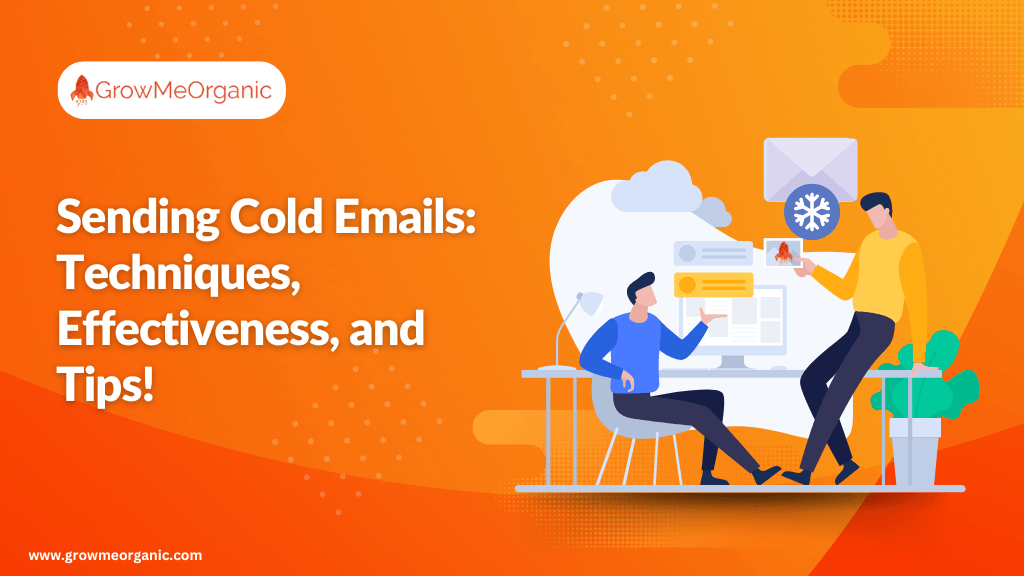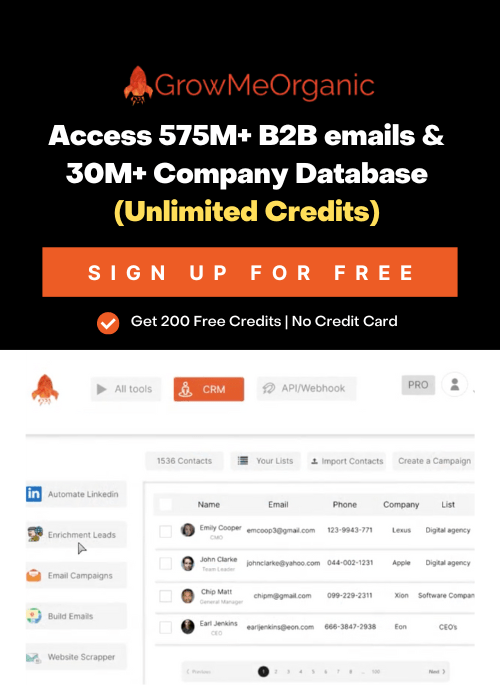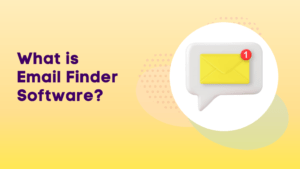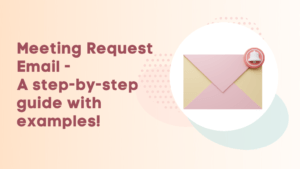A cold email is a powerful and intriguing communication method. But each part of the email must deliver value to stand out from an average professional’s daily inbox. Sending cold emails in a strategic and professional way helps you get replies.
Specific factors, like an impactful introduction or product USP, determine whether a cold email will have a high response rate. However, the fundamental concept remains simple—it must draw attention and offer value.
Find below step-by-step guide for effective cold emailing. Explore different samples and get crucial tips to increase your conversion rates.
What Is Cold Emailing?
A cold email is sent to someone you haven’t met before. It serves a legitimate business purpose, distinguishing it from spam.

The main difference between cold emails and cold calls is the communication method. The former is easier to send in large numbers.
Examples of cold emails include:
- A sales email to a CEO or manager on your prospect list to set up a demo.
- An email to someone in your industry to build brand awareness and network.
- An email to a company that might hire someone with your skills to organize an informational interview.
A cold email is “cold” because there is no prior relationship.
Format For Sending Cold Emails
| Subject Line | An excellent cold email subject line grabs someone’s attention and makes them open your email. Crafting a compelling subject line needs both skill and creativity. The best subject lines engage the reader and provide value. They offer valuable information and spark curiosity, helping build a connection. |
| Email Opening | People love hearing their own names. Start an email with the recipient’s name to get their attention. This makes the email feel more personal and less like it’s from a stranger. If you’re writing to someone in a position of authority, use a more formal greeting. To make an excellent first impression, find out the person’s name and job title. |
| Email Body | Avoid starting with something generic. Mention something personal that relates to the topic. Introduce yourself and state your purpose or compliment them on a recent achievement. You can also start with a question that leads to your main point or include an interesting statistic. |
| CTA | Every email has a goal, like asking for information, prompting a click, or requesting a reply. Having the right call to action is crucial for a successful cold email. Keep CTAs straightforward and directly ask for a response. |
| Ending | A simple thank you can make a big difference. Ending your emails with gratitude makes the recipient feel appreciated. Try to personalize for a better response. And remember to include your signature. |
A Step-By-Step Guide For Sending Cold Emails Effectively
1. Begin By Greeting The Recipient Using Their Name
Start the email by greeting the recipient using their name. However, mentioning the recipient’s name randomly in the email is not personalization. It means understanding who the person is, their perspective, interests, and needs. It shows you’ve made an effort to know them.
Explain why you’re emailing them specifically. Research shows that people are more likely to help when they feel uniquely qualified. Show how they fit into your request to increase the chances of a positive response.
2. Use A Personalized Opening Line
You have around 3 seconds to catch the recipient’s attention. So avoid starting with a line that is found in any average email. Instead, use what you know about them to make it personal and relevant.
Compliment their recent work or start with a question that introduces your key point. You can also skip the opening line and get straight to the business. It’s better to be direct than to use unnecessary greetings.
3. Self Validation To Build Trust
Establishing trust and familiarity is essential to connect with the recipient. You can mention mutual acquaintances or connections to bridge the gap between strangers. If you have any relevant achievements or roles, mentioning them can also boost your credibility.
Finding common ground, like shared hometowns or hobbies, further strengthens your bond. Remember, everyone starts as a stranger, so sharing about the similarities can be impactful. But keep it concise and brief, focusing on the recipient’s interests and needs.
4. A Brilliant Introduction Defining Your Purpose
Starting a cold email is tricky. Often, we talk too much about ourselves and our company, wanting to seal the deal quickly. But there are better ways to go. A cold email intro should be brief, like two to three sentences.
Instead of talking about you, focus on them—the person you’re emailing, their work, achievements, or their company. A little flattery works, but keep it professional. And remember, research their company before sending cold emails.
5. Try To Highlight Common Association Points Or Similarities
If you know the person you’re reaching out to, that’s the best way to make a connection. It conveys that you two are not strangers. If you don’t have that, it’s okay. You can mention if you’re known for something important.
But if you’re not, even that is alright. Look for something you have in common, like being part of the same club or having similar interests. Finding these common association points or similarities helps you create a significant impact.
To highlight similarities in cold emails, research the recipient’s background. Refer to these points in your email to establish rapport. You can mention mutual contacts, shared experiences, or common goals. Keep it genuine and relevant to the purpose of your email.
6. Time To Address Pain Points
Think about why a recipient should care about any email. What does it offer that the user takes some time out and answers to it. Your research must find out the recipient’s pain point and provide adequate solutions via email.
The goal is to give the recipients something they need. If you give them what they are precisely looking for, your cold email will stand out among hundreds of others. When you show them how you relate to the issue, you are viewed as a partner rather than an ordinary salesperson.
7. Draw Attention To Your Unique Selling Proposition
When you send a cold email, you only have a few seconds to grab the reader’s attention. This is why including a value proposition is mandatory. A value proposition quickly tells your audience what you offer and why it matters to them.
A good value proposition shows you understand what the recipient needs or worries about. It conveys how your product or service can help. By highlighting what makes your offer unique, you show the recipient why they should pick your solution over others.
This makes your email more interesting and increases the chances that the recipient will keep reading. If your value proposition matches their needs, it creates a connection that encourages further engagement.
Here are some examples of what you can offer:
- A way to solve a problem they are facing
- A helpful resource
- Useful information or data
- Introducing them to a valuable networking contact
- Arranging an informational interview
- Connecting them with someone who shares their interests
No matter what you provide, make sure it benefits them in some way.
8. Include A Clear Call-To-Action
Imagine your recipient has read your email, is impressed by your product, but isn’t sure what to do next. This happens a lot with cold email campaigns. Even with the best email copy and subject line, no conversions happen without a solid call to action (CTA). It is because a CTA guides users on what to do next, like scheduling a meeting, call, or consultation.
Be clear about what you want them to do next. Don’t be too pushy; it might annoy prospects who aren’t ready to buy yet. Keep the CTAs clear, short, and direct for the best results.
9. Remember To Appreciate The Recipient
A simple thank you can make a big difference. With appreciation, you not only seem humble but also make the recipient feel good. Letting them know they can say no will actually make them more likely to say yes.
Many people make the mistake of sounding entitled in their cold emails. People are more likely to help when they enjoy doing it rather than feeling obligated. Be confident, but don’t sound forceful.
10. Email Signature Is A Must-Have
Always include a professional email signature with your name, job title, company, phone number, and email address. This makes it easy for people to contact you.
A good email signature acts like a digital business card and creates a lasting impression. Including your company’s name, logo, and colors helps people remember your brand.
It also facilitates communication and builds trust with potential clients. It provides key contact details and social media links, which leads to higher response rates and stronger business relationships.
Cold Email Samples For Better Understanding
Cold emails are written in different ways based on the user cases. Here are some examples to help you understand how to write them.
1. Cold Email For Job
- When writing for a job application, begin with your personal introduction.
- Address the recipient with a name for a personalized approach and state the purpose clearly.
- Do not overextend the email.
- Keep it brief and include relevant skills and experiences, avoiding unnecessary details.
- Mention your qualifications and past job experiences to represent yourself as a suitable candidate.
- Remember to include the motivation factor behind your application. Show appropriate enthusiasm for the vacancy to confirm your spot.
- Wrap your email with the correct CTA and proofread before sending.

2. Cold Email For Internship
- Begin with a personalized greeting and a short subject line.
- Include your name, current educational status, and the purpose of your email.
- Mention any coursework, projects, or experiences to highlight qualifications.
- Explain why you want to intern at that particular company and how it aligns with your career goals.
- Show that you are keen to discuss how you can contribute to the company.
- Make it easy for the recipient to reach you and review your qualifications.
- Include proper contact information and attachments.

Cold Email For Executives
- Before writing, understand the executive’s role and background.
- Make it specific and relevant to catch the executive’s attention.
- Personalized greetings, brief introductions, and stating purpose are a must.
- Mention your name, current position, and background.
- Clearly explain why you are reaching out within the first few sentences.
- Refer to recent news, projects, or initiatives of the company that relate to your proposal or interest.
- Suggest a clear next step, like a meeting or a call.
- Thank them with a professional closing statement.
- Include signature and other contact details.

Cold Email For Clients
- Identify key decision-makers to address the email to the right person.
- Keep it concise and relevant to the client’s interests.
- Avoid generic phrases; instead, hint at the value or benefit.
- Start with a statement or question that addresses their pain point or goal.
- Briefly describe who you are and what your company does. Explain how your product or service can solve their problem.
- Use specific examples or case studies to demonstrate value.
- Avoid lengthy paragraphs; keep the email brief and to the point.
- Ensure the tone is professional.

Cold Email For Startup
- Learn about the startup’s mission, values, and products.
- Start with a brief introduction that includes your name and current position.
- Mention how you found out about the startup or why you are reaching out.
- Define specific aspects of the startup that excite you.
- Explain how your skills and experiences can benefit the startup.
- Be specific about the value you can bring.
- Suggest a meeting or phone call to discuss further.
- Thank them for their time and consideration.

Cold Email After No Response
- Give the recipient enough time to respond before following up. Waiting 5-7 business days is appropriate.
- Write a concise and attention-grabbing subject line that indicates it’s a follow-up.
- Begin with a friendly greeting, acknowledging that you understand they might be busy.
- In a sentence or two, remind the recipient of the context of your previous email.
- Offer something of value or additional information that may pique their interest.
- Politely ask for what you’re seeking, whether it’s a response, a meeting, or further discussion.
- Thank them for their time.

Quick Tips To Perfect Your Cold Emailing Campaign
- Different articles suggest different best times for sending cold emails. Some say it’s between 8 and 9 in the morning. However, this mainly applies if you’re sending tons of emails to extensive email lists. The most effective cold emails result from adequate research and understanding of the target audience. With the right effort, send your email anytime and still expect a positive response.
- Find popular cold email templates to save time on writing. Tools like GrowMeOrganic can be used for custom intros and CTAs, as well as for preparing hyper-personalized cold emails.
- Keep cold emails short and precise. Briefly explain how your product or service can solve the recipient’s problem. Make it easy for them to understand. The quicker they see the benefit, the more likely they’ll be interested.
- With good cold email software, you can easily create and fully automate your cold email outreach campaign. Software like GrowMeOrganic provides features like personalization, bulk emails, automated follow-ups, and more.
- With a B2B sales email, we’re not just trying to make a quick sale. The goal is to begin a special business connection with a potential buyer. This means being subtle and personal is vital. The key is to focus on the potential buyer. Think about what they need and how to address their pain points. Show them that you understand their problems and can offer solutions.
- Avoid simply listing what the product does or costs. Focus on what it can do for the recipient. Think about how it can make their life easier or better. Do not say, “Our product has a fast processor.” Try, “With our product, you can get tasks done quicker, saving you time.”
- Segmenting your email recipients into different groups makes a huge difference. It means dividing people into smaller groups based on their interests, issues, or engagement. With this, create content that’s just right for each group.
- Sending follow-up emails after your first message is crucial. Not everyone reads your cold email carefully. It is because people get tons of emails daily, so yours might be overlooked. When you send a follow-up, it shows that you really want to connect. It intrigues the recipient and helps build a stronger relationship.
Final Thoughts
When done correctly, sending cold emails is among the most effective outreach methods. Follow the above step-by-step guide and quick tips to see positive results. Remember, a short and personalized email targeting a specific audience is ideal for developing new business relations.
With email sequences and automated follow-ups, it can be your lead-generation machine. Effectively sending cold emails means being consistent and not too aggressive. Aim to help your recipients by highlighting their pain points, and you are good to go.
About Post Author
Anant Gupta
Growth Hacker, Marketing Automation Enthusiast & Founder of GrowMeOrganic























